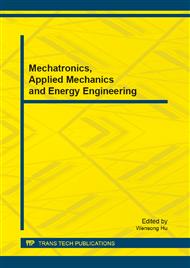[1]
M. Vukobratović and Yu. Stepanenko, On the stability of anthropomorphic systems, Mathematical Biosciences, vol. 15, no. 1, pp.1-37, (1972).
DOI: 10.1016/0025-5564(72)90061-2
Google Scholar
[2]
M. Vukobratović and B. Borovac, Zero Moment Point - Thirty Five Years of its Life, Int. l J. f Humanoid Robotics, vol. 1, no. 1, pp.157-173, (2004).
DOI: 10.1142/s0219843604000083
Google Scholar
[3]
S. Kajita, F. Kanehiro, K. Kaneko, K. Yokoi, and H. Hirukawa, The 3D Linear Inverted Pendulum Mode: A Simple Modeling For A Biped Walking Pattern Generation, in Proc. IEEE Int. Conf. Intell. Robots Syst., 2001, pp.239-246.
DOI: 10.1109/iros.2001.973365
Google Scholar
[4]
Pandu RangaVundavilli and Dilip Kumar Pratihar, Balanced Gait Generations of a Two-Legged Robot On Sloping Surface, Sadhana, vol. 36, part 4, p.525–550.
DOI: 10.1007/s12046-011-0031-7
Google Scholar
[5]
N. T. Phuong, D. W. Kim, H. K. Kim and S. B. Kim, An Optimal Control Method for Biped Robot with Stable Walking Gait, in the Proc. of 8th IEEE - RAS Int. Conf. on Humanoid Robots, Daejeon, Korea, December 2003, pp.211-218.
DOI: 10.1109/ichr.2008.4755947
Google Scholar
[6]
T. McGeer, Passive dynamic walking, Int. J. of Robotics, vol. 9, no. 2, pp.62-82, (1990).
Google Scholar
[7]
Ambarish Goswami Bernard Espiau Ahmed Keramane, Limit cycles and their stability in a passive bipedal gait, in the Proc. of the 1996 IEEE Int. Conf. on Robotics and Automation, Minneapolis. Minnesota - April 1996, pp.246-251.
DOI: 10.1109/robot.1996.503785
Google Scholar
[8]
A. Goswami, B. Espiau and A. Keramane, Limit cycles in a passive compass gait biped and passivity mimicking control laws, Autonomous Robots, vol. 4, no. 3, pp.273-286, (1997).
DOI: 10.1023/a:1008844026298
Google Scholar
[9]
A. Goswami, B. Thuilot, and B. Espiau, A Study of the passive gait of a compass – like biped robot: Symmetry and chaos, Int. J. Robot. Res., vol. 17, no. 12, pp.1282-1301, (1998).
DOI: 10.1177/027836499801701202
Google Scholar
[10]
A. Chemori, A. Loria, Walking control strategy for a planar under-actuated biped robot based on optimal reference trajectories and partial feedback linearization, in Proc. of 4th Int. Workshop on Robot Motion and Control, 2004, pp.61-66.
DOI: 10.1109/romoco.2004.240640
Google Scholar
[11]
Y. Hu, G. Yan, and Z. Lin, Feedback control of planar biped robot with regulable step length and walking speed, IEEE Trans. on Robotics, vol. 27, no. 1, p.162 – 169, (2011).
DOI: 10.1109/tro.2010.2085471
Google Scholar
[12]
M. W. Spong, J. Holm, and D. Lee, Passivity-based control of bipedal locomotion, IEEE Robot. Autom. Mag., vol. 14, no. 2, pp.30-40, (2007).
DOI: 10.1109/mra.2007.380638
Google Scholar
[13]
Fumihiko Asano, Stability Analysis of Underactuated Bipedal Gait Using Linearized Model, in Proc. of 11th IEEE-RAS Int. Conf. on Humanoid Robots, 2011, p.282 – 287.
DOI: 10.1109/humanoids.2011.6100805
Google Scholar
[14]
S. Kochuvila, Shikha. Tripathi and Sudarshan T S B, Control of a Compass Gait Biped Robot Based on Partial Feedback Linearization, Advances in Autonomous Robotics, Lecture Notes in Computer Science(LNCS), Springer Link, Volume 7429, pp.117-127, August, (2012).
DOI: 10.1007/978-3-642-32527-4_11
Google Scholar


